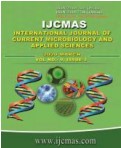


 National Academy of Agricultural Sciences (NAAS)
National Academy of Agricultural Sciences (NAAS)

|
PRINT ISSN : 2319-7692
Online ISSN : 2319-7706 Issues : 12 per year Publisher : Excellent Publishers Email : editorijcmas@gmail.com / submit@ijcmas.com Editor-in-chief: Dr.M.Prakash Index Copernicus ICV 2018: 95.39 NAAS RATING 2020: 5.38 |
Floriculture has emerged as an important sub-sector of agriculture as a source of income for small and marginal farmers. In India, Tamil Nadu state is the leading producer of jasmine with an annual production of 77,247 tonnes from the cultivated area of 9,360 ha. In Madurai District of TamilNadu, jasmine is being cultivated in an area of 1,250 hectares with an average productivity of 7.85 tonnes per hectare and is famous for its GI product Madurai Malli. Even though the area is more the scientific way of cultivation is poor. The small and marginal farmers are facing many problems not only in cultivation but also in marketing their produce. Hence, they are unable to meet the demands of raw flowers required from industries and other countries. Keeping the above situations in mind, an attempt has been made to identify the yield gap and real problems faced by the farmers in production and marketing and also the prospects of this sector to stabilize the productivity. The study was carried out in Madurai District with jasmine growers through problem ranking method in participatory approaches. The results revealed that 1.3 t/ac of yield gap I was prevailing in jasmine and with respect to production constraints, unavailability and high cost of labour, pest and diseases, monsoon failure, lack of proper pruning were the major constraints. With regard to marketing constraints, commission agents, pre harvest agreements, heavy fluctuations in price, perishability nature, lack of technical guidance on export of flowers and awareness on GI were the constraints felt by the farmers. Awareness on recommended fertilizer and pruning management and proper chemicals for pest and disease control is felt essential among the farmers. Importance and benefits of Geographical Indication for Madurai malli should be disseminated among the farmers to get good market price in the national and International markets.
 |
 |
 |
 |
 |